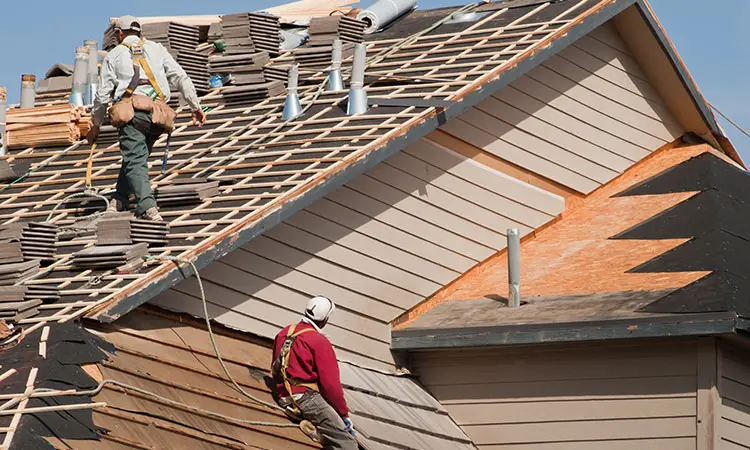Proficient Roofer for Quick Repairs and Roof Upgrades
Proficient Roofer for Quick Repairs and Roof Upgrades
Blog Article
Cost Aspects to Think About for Your Future Roofing System Replacement Job
When getting started on a roofing system substitute project, understanding the different cost variables is critical for efficient budgeting. Key factors to consider consist of the selection of roof covering products, which not just influence preliminary expenses however additionally long-lasting sturdiness, as well as labor expenses driven by the proficiency of service providers and local wage criteria.
Roofing Material Selections

Asphalt roof shingles are among the most typical alternatives as a result of their price and ease of installation. However, they might require replacement faster than other products, impacting long-term prices. Steel roofing, while at first more costly, flaunts phenomenal longevity and can last years with very little upkeep, making it an economical alternative gradually

Finally, timber trembles offer an all-natural aesthetic but call for regular upkeep to protect against rot and bug damage, potentially enhancing future costs. Eventually, picking the ideal roofing product is a critical choice that influences not just the immediate budget however also the future financial implications of roof maintenance and replacement.
Labor Expenses and Incomes
The experience and ability of roofing professionals considerably affect the general price of a roof substitute task. Labor expenses generally make up a significant section of the overall expenditure, varying based on the experience and credibility of the specialist. Highly experienced workers command higher salaries due to their training and effectiveness in implementing intricate roof covering jobs.
A number of aspects add to labor expenses, including local wage prices, the need for roofing services, and the seasonality of the building and construction market. In urban locations or places with a high expense of living, labor rates tend to be elevated - roof replacement. Furthermore, throughout peak seasons, when the demand for roofing services surges, service providers might boost their rates accordingly
A more skilled staff might work extra efficiently, potentially minimizing labor hours and overall costs. Investing in competent labor can lead to an extra long lasting and trusted roof covering, inevitably conserving prices on future repair work.
Roof Style Complexity
Roofing system layout complexity plays an important role in figuring out the total price of a roof replacement job. The intricacy of a roofing's layout directly impacts labor requirements, product choices, and project duration. Extra intricate roof Web Site covering designs, such as multi-gabled or vaulted frameworks, commonly require extra labor hours and specialized abilities, boosting overall expenses.
Additionally, the type and amount of products needed can differ significantly based upon the roofing's geometry. Roofing systems with high inclines or unique building attributes may require custom-cut products, which can be a lot more expensive than common options. Additionally, the capacity for boosted waste throughout installment must be considered, as elaborate layouts may lead to greater product costs.
Furthermore, complex roofs can pose safety and security challenges for service providers, demanding improved safety measures and devices, which may even more pump up labor expenses. These factors underscore the significance of thoroughly assessing your roof covering's layout complexity when budgeting for a substitute.
Inevitably, house owners ought to collaborate closely with their professional roofer to completely understand just how visit this web-site design complexity will impact their job's economic extent, ensuring educated choices that line up with both aesthetic preferences and monetary restraints.
Permits and Rules
Browsing licenses and guidelines is an essential facet of any roof substitute job that can substantially influence total expenses and timelines. Before starting work, house owners should guarantee compliance with local structure codes, which may differ by district. These codes frequently dictate architectural demands, roof products, and even aesthetic factors to consider, specifically in historic districts.
Obtaining the essential licenses is not only a lawful obligation yet can additionally stop expensive fines and job delays. Generally, the application procedure includes sending in-depth strategies and requirements, along with paying associated charges. Depending upon the intricacy of the project, examinations may be called for at different stages, contributing to the timeline and labor prices.
In addition, some regions might have details policies concerning power performance, which might demand making use of specific materials or techniques that may be much more expensive in advance but yield long-lasting cost savings. Engaging with a qualified specialist that is acquainted with local regulations can simplify this process and assistance minimize threats. Eventually, understanding and dealing with authorization and regulatory requirements early in the planning stage can facilitate a smoother, more cost-efficient roof replacement task.
Hidden Costs and Backups
Anticipating concealed costs and contingencies is essential for home owners intending a roofing system replacement, as these expenses can quickly escalate the initial budget plan. While the priced estimate rate might cover the noticeable facets of the job, unpredicted aspects typically develop, requiring extra economic allotment.
One typical covert expense is the exploration of underlying structural damage throughout the removal of the old roofing system. Concerns such as rot, mold, or tatty sheathing can need prompt interest, bring about enhanced labor and material expenses. Additionally, if your home has numerous layers of roof, the cost of elimination can be dramatically more than expected.
An additional element to consider is the expense of products. Costs can rise and fall based upon market conditions, and unexpected shortages might demand last-minute substitutions, potentially influencing the budget. If weather condition problems delay the project, extra labor prices might accrue.
To reduce these threats, it is prudent look these up to set apart a contingency fund-- usually 10-20% of the complete task cost. This fund can supply a financial buffer against unpredicted expenses, making sure that your roof covering substitute project proceeds smoothly and within budget plan. Proper planning and foresight will aid homeowners navigate these intricacies efficiently.
Conclusion
Finally, an extensive understanding of expense variables is important for an efficient roofing substitute task. The selection of roof materials, labor costs, and the intricacy of the roof design considerably affect the general spending plan. Additionally, compliance with licenses and regulations, alongside the recognition of hidden prices and the facility of a contingency fund, makes sure readiness for unexpected expenses. By dealing with these aspects, home owners can achieve a successful and economically workable roof project.
Report this page